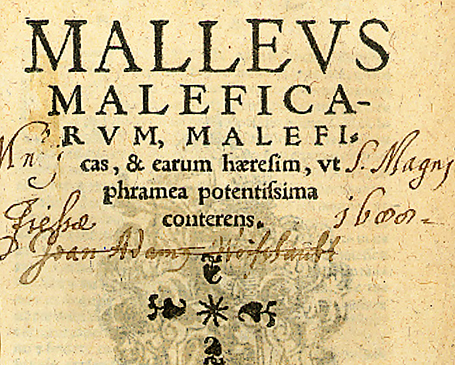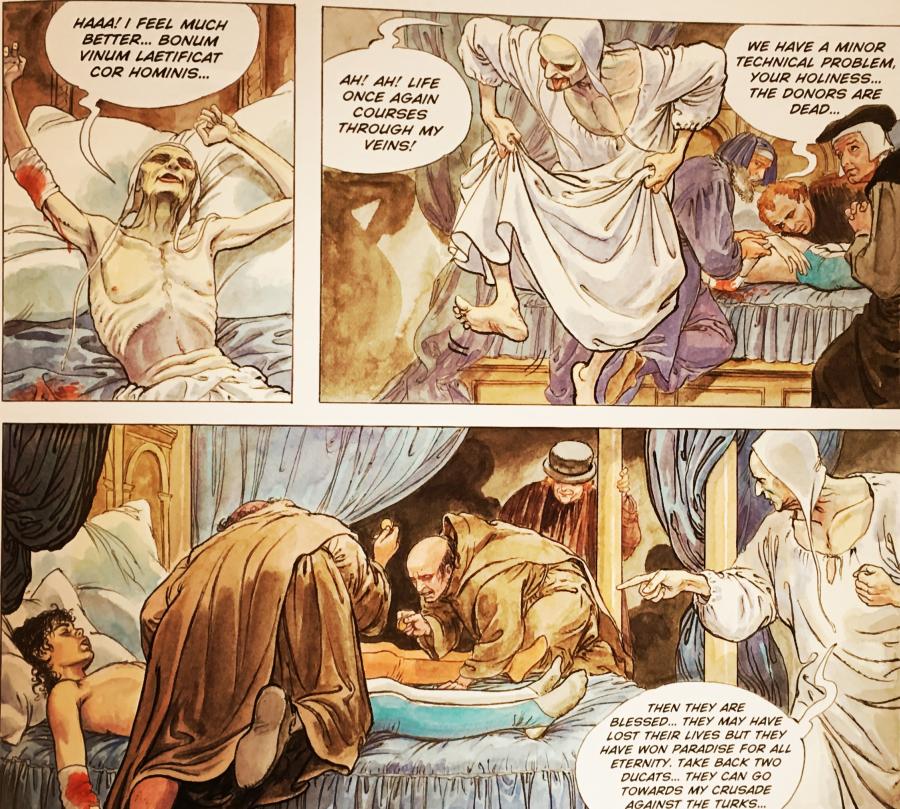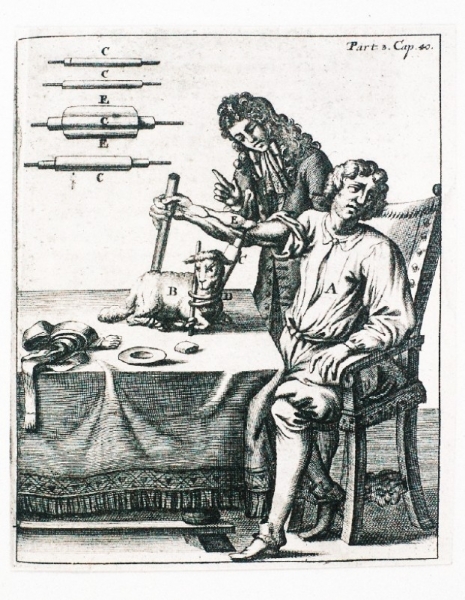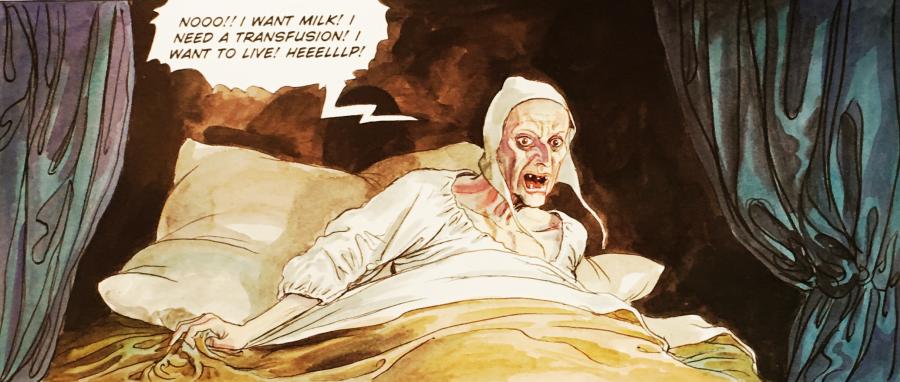There’s some discussion of modern vampirism over at PZ’s [phar] and modern ultra-creepy vampire Peter Thiel [affinity] came up, as he’s wont to do.
Thiel comes from a long line of creepy people, and, not that I want to be mistaken for defending Thiel, he’s got a long way to go before he gets close to the creep-factor of some of the vampires of yore.

“Witch Hammer”
Pope Innocent the VIII was one of the all-time creepy catholics; he makes most of the current crop look like utter pikers in comparison. For one thing, Innocent was the pope who was indirectly responsible for the ascendancy of witch-hunting in Europe. His papal bull Summis Desiderantes[wik] was intended to green-light the witch-hunting activities of one Heinrich Kramer, who wanted authority to hunt witches throughout most of what is now Germany – due to procedural flaws, Kramer was stymied and retired, to write “My Big Book of Witch Burning” [wik] the Malleus Maleficarium. Innocent also made a key hire, appointing Tomas De Torquemada as the grand inquisitor for Spain. [wik] By all accounts he was a pretty bad pope, which is saying something, who blew through money on wild parties and corruption, sold bishoprics to raise cash, and, basically, did the best he could to act like Donald Trump before the invention of golf.


I hope it wasn’t a painful death.
Following the tradition of the power-blinded elite, Innocent – who had unleashed armies of sadists to torture ‘witches’ – was a thorough-going hypocrite. He did not see “medicine” as ‘witchcraft’ though, if you went back to 1480 you’d have a hard time telling them apart. Except that ‘witchcraft’ was probably what women did, whereas ‘medicine’ was done by male doctors. Transfusing people, when you understand nothing about blood types, virology, infection, or blood clotting – is just magical thinking: like unto like; if you eat the blood of youth it’ll give you some of their youth, etc.
Innocent’s personal physician, one Giacomo Di San Genesio allegedly gave him the blood of a half dozen babies to drink, and tried a transfusion between the old, dying pontiff, and some young men. That polished the pontiff off, and Giacomo, who had made the mistake of being jewish, may have been calumnied regarding the incident – history brings down a curtain over Giacomo’s fate but somehow I suspect it was not a happy retirement playing golf somewhere.
The pope, nearly immediately suffered a massive stroke, and died shortly thereafter, though apparently the doctor – not having much other idea what to do – tried to revive him by pumping more children’s blood into the vampire pontiff.
If you like your “Game of Thrones” and a mix of sex and violence, there’s an illustrated series about the Borgias written by Jodorowsky and illustrated by Milo Manara.[amaz] It has some gorgeous but horrible illustrations of some of the shenanigans of the day, including the papal transfusion incident.

It’s always thus: the rich and powerful will do anything to cheat the great leveller for another day. After all, what else is the point of wealth and power?

Milo Manara is one of my favorite artists; I loved his stuff as a teenager because it’s full of sex and violence. I realize that’s problematic but I still like it. My interpretation and perception of some of Manara’s works has changed considerably over the years. There’s a whole lot of art I grew up on, Tintin, Hugo Pratt, Druillet, Manara, Jodorowsky, that – especially Tintin – reeks of colonialism and racism, or violentized eroticism. I spent a lot of my time in the summers reading Pilote magazine – the French comic journal that was brought over to the US as Heavy Metal in the 80s – it undeniably had a formative influence on me. Today’s generation will eroticize what they see on Game of Thrones, I suppose.

I remain very skeptical indeed about the blood transfusion story. The source is the Diary of the City of Rome, by one Stefano Infessura, who was a lawyer, historian and civic official attached to the Colonna family in Rome. He was also the secretary to the Roman Senate for many years, and thus in a position to hear all kinds of 15th Century Roman gossip. 15th Century Rome was a very divided city – divided between the civic authorities (and the nobility who ran them) and the Papal authorities. Infessura was a very partisan pro-city writer – any lurid stories about Papal misdeeds would fit with his agenda. So it is immediately suspicious. It’s of a piece with all the gaudy horrors attributed to hated Roman Emperors – and as a good humanist scholar Infessura would have been intimately acquainted with Suetonius and the Historia Augusta.
Also, the whole tone of it is pitched perfectly to plug right in to late medieval sensibilities – Jews and unholy blood rites had a long history together in the racist imagination, doctors were frequently seen as suspicious and atheistic, and innocent children were guaranteed to add to the horror. Innocent’s papal name was frequently made fun of – Latin poets tended to refer to him as “Nocens” (“harmful”, the opposite of “innocens” – not harmful), and there were all kinds of critical stories circulating, even among clerks from the Curia, about his actual excesses – illegitimate children, support for Barbary slavers, greed and venality and his disastrous political ambitions trying to stir up a new crusade against the Turks.
As with Trump, there was so much to condemn the bastard over that could be evidenced that we really don’t need to trust the lurid horror stories too.
Though Heinrich Kramer was also a Trump-level self-publicist. When the time came to submit the Malleus for publication he actually appended a copy of the Summis desiderantes bull to the front, to give the impression that Innocent had given an official seal of approval to the book, rather than to his inquisitorial activities in the Empire. He also appended a fraudulent recommendation from the University of Cologne, where his alleged co-author Jakob Sprenger was Master of Theology. It is uncertain how much help Sprenger gave Kramer in writing the Malleus – the two separated amid great acrimony after 1487 when the book was first published (without Sprenger’s name on the titles), and Sprenger did everything he could to impede Kramer for the remainder of his life. Unfortunately that lasted another eight years and then he died, at which point Kramer had him credited as co-author to bring additional academic credibility to the enterprise.
This would prove important in later years as, under the Caroline Legal Code used in the Empire from 1530, University theology faculties had an important legal role in determining facts in witchcraft trials.
cartomancer@#1:
Also, the whole tone of it is pitched perfectly to plug right in to late medieval sensibilities – Jews and unholy blood rites had a long history together in the racist imagination, doctors were frequently seen as suspicious and atheistic, and innocent children were guaranteed to add to the horror.
Yes, that’s definitely a red flag.
So, perhaps this was Innocent’s “pee bed” equivalent. #Fakenews
It’s so interesting, to me, that the line between “magic” and “medicine” appears to have been clear to them, but looking back from the 21st century, it all looks like magic from here.
Another victim of the witch hunts: beer.
Nearly all the symbols we associate with witches – the pointed hats, the black cauldrons, the cats, the brooms – originated from brewers and beer sellers in the 15th century and before. Beer-making and selling was almost exclusively done by women in most of Europe.
The symbols aren’t a coincidence. Brewers made their “witches’ brews” in large cauldrons; they kept cats to keep mice away from the grain; the broom was a symbol placed above the door of a beer maker, indicating they had beer for sale; and the pointed hat was worn when the brewers took their beer to market, to attract customers.
Naturally, Pope Innocent’s Church wasn’t happy with women making all the beer, so they burned them and tortured them and let men take over the market, destroying centuries of beer-making traditions and recipes.
Read more: https://brewhoppin.com/2015/10/the-truth-of-women-and-beer-witches/
invivoMark@#4:
Another victim of the witch hunts: beer.
Whaaaaaaaaat!!?!
I had no idea! Thanks for sharing that fascinating bit.
Yeah, the idea of drinking young people’s blood sounds worth giving a try as long as you know nothing about how digestion works.
Early blood transfusions were statistically highly likely to kill the patient. First some doctors experimented on dogs and found out that it is possible to successfully make blood transfusion between two dogs. And afterwards they came to the “obvious” conclusion that giving a human patient some animal blood is a great way how to cure the patient. It didn’t work and patients were dying from this.
Then it took few more centuries until James Blundell finally figured out that human patients need human (and not dog or sheep) blood. Blundell performed several successful blood transfusions only to notice that their success rates were random and, in some cases, outright abysmal.
After decades of low success rates (and dozens of dead patients) Karl Landsteiner finally discovered blood types in 1901. He took samples of blood from several healthy people and decided to see what would happen if they were mixed together in a test tube. While some of the samples didn’t react, others would form clumps and agglutinate (that’s what previously killed all the patients who received blood of the wrong type).
I could buy the idea that some old, evil, and rich person tried drinking baby blood to prolong his life. I’m not going to buy the claim that he received multiple blood transfusions and actually survived. Before 1901 it was possible to survive after a single blood transfusion (if you were lucky and accidentally got the right blood type). But surviving multiple blood transfusions from different donors would require an extraordinary amount of luck.
Now, the truly interesting fact is that when an old patient gets blood from a young donor, it actually sort of works (under specific conditions) and can actually help alleviate some age related health problems.
https://www.economist.com/news/science-and-technology/21724967-might-be-true-people-too-blood-young-animals-can-revitalise-old There have been plenty of experiments were an old lab rat got a young rat’s blood and it improved the old rat’s health in some small aspects.
The old “vampires” actually had the right idea. Except that it didn’t exactly work as they had hoped it would. And then there’s the whole concept of “nuance”, namely, it’s not that simple.